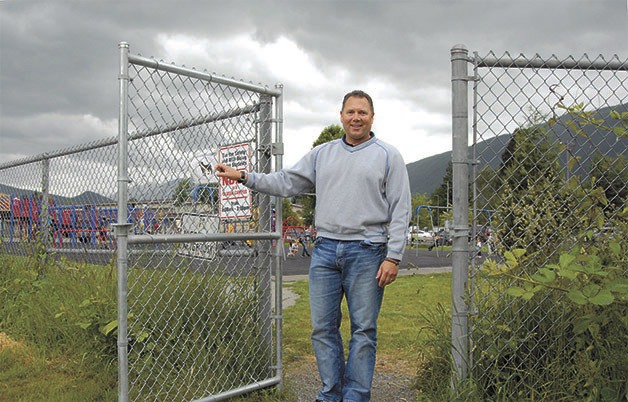Every school building in the Snoqualmie Valley School District wants to bump up its security levels these days. From a parent-funded electric door pilot project at Fall City Elementary to a proposed fence around the North Bend Elementary School playground, “We have requests from all of the buildings, for things they’d like to do to improve safety,” says district director of business services Ryan Stokes.
Granting the requests, though, is more complex than just finding the money.
That’s because, Stokes explained, they raise questions about equitable spending among buildings, how the district could ensure security at each school, and whether each school should be allowed to set its own standard.
Regarding the North Bend Elementary fence, there are still more issues.
The estimated cost of the fence, $12,000, has been included in the school district’s 2013-14 budget, said Stokes, but “there’s lots of stuff involved beyond just plopping down a fence.”
One issue is the city of North Bend’s sewer line easement through the field to be fenced. Another is parent opposition to the district’s plan to fence 109,000 square feet, which includes the entire field behind the school, not just the playgroun. Also, staff members aren’t sure the fence will really address parents’ safety concerns.
Jim Frazier, principal of the 550-student North Bend Elementary School, has been working with a parent group for several months on a fence proposal, well before the May 22 launch of an online petition to fence the playground (www.change.org/petitions/snoqualmie-valley-school-district-superintendent-completely-fence-the-playground-at-north-bend-elementary-school). He’s skeptical that the fence alone will solve the problems, as parents see them — broken glass, used condoms and hypodermic needles left after school hours on the playground.
“Putting a fence in isn’t going to stop glass on the playground, … it’s not going to stop some of the other things that happen on a playground at night,” he said.
It won’t stop hypodermic needles from appearing on the grounds, either, because there haven’t been any, he says. “In the eight years I’ve been here, yes, but this school year we’ve had no needles.”
Community forum
Other parks have had problems with needles though, as parent Christina Knight pointed out at the city of North Bend’s community forum on public safety May 16. She was one of several parents who mentioned finding needles in city parks, and said she’d had a conversation with Frazier about how, “a lot of kids don’t know what to do with a needle, if they find one.”
Needles are just a symptom of the issue, though, says Frazier. “I think parents are pretty much concerned about some of the transients that are coming through the neighborhood,” he said.
Transients are frequently blamed for the needles found in city parks, as well as other litter, but Frazier didn’t notice any increase in these problems since the opening last December of the emergency winter shelter, hosted at North Bend Community Church and later at Mount Si Lutheran Church.
“The homeless shelter didn’t really affect us here at our school,” he said.
The fence would keep transients off school property during school hours, but, like the fence separating the school grounds from the Snoqualmie Valley Trail, its gates would be unlocked before and after school hours for the convenience of students who walk to school across the field, and to allow public access to the school playground outside of school hours.
“We would still practice that,” Frazier said, if and when a fence is installed.
Playground or field
When parents first approached Frazier about fencing the children’s play area, they suggested enclosing just the playground. Parents who spoke at the June 13 Snoqualmie Valley School Board meeting called for the same thing, citing both the preservation of the “park” along Third Avenue, and student safety.
“We have long considered ourselves stewards of this public land,” said Phil Lacefield, Jr., a parent, speaking during the public comment period of the board meeting Thursday. He noted that his family uses the park daily and often picks up litter and occasionally calls the police when needed.
“Fencing in this entire open space seems unnecessary, overly costly, and will ultimately prove more dangerous to the children it’s supposed to protect,” he added, since playground supervisors will be unable to monitor all the students in such a large area.
Parents and school board candidates David Spring and Steven Kangas also supported Lacefield’s comments. Spring called for a public hearing on the issue, and a public vote by the school board. Kangas noted that “most of our school safety issues are within the school, not without.”
Former school board member Rudy Edwards also critized both the board and the fence proposal, which was made generally known after an e-mail announcement from North Bend Elementary School that the funding was in place for the fence.
“I think people historically want to keep the park open,” Edwards said. “You can’t just send out e-mails, and not vote for stuff, and be an advocate of our district.”
During the public comments, board member Carolyn Simpson, presiding during the absence of President Scott Hodgins, told the audience that district staff members were still gathering information and comments about the project, and, although their comments were welcome, they were “a little premature to bring to the board.”
The grounds proposed to be fenced are actually school property, not a public park as many people have assumed. Students already use most of the field during recess and before or after school, Frazier said, so fencing in only the playground wouldn’t really be feasible.
The area has about 400 students with five supervisors, plus teachers both before and after school. During recesses, up to 170 students play outside, supervised by three or four adults.



